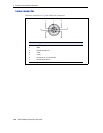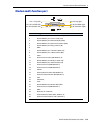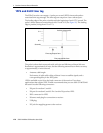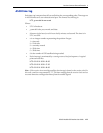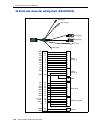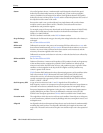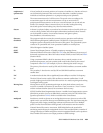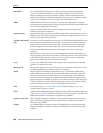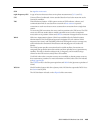
Glossary
182 SPSx51 Modular GPS Receivers User Guide
OmniSTAR The OmniSTAR HP/XP service allows the use of new generation dual-frequency
receivers with the OmniSTAR service. The HP/XP service does not rely on local
reference stations for its signal, but utilizes a global satellite monitoring network.
Additionally, while most current dual-frequency GPS systems are accurate to within a
meter or so, OmniSTAR with XP is accurate in 3D to better than 30 cm.
PDOP Position Dilution of Precision. PDOP is a DOP value that indicates the accuracy of
three-dimensional measurements. Other DOP values include VDOP (vertical DOP) and
HDOP (Horizontal Dilution of Precision).
Using a maximum PDOP value is ideal for situations where both vertical and
horizontal precision are important.
postprocessing Postprocessing is the processing of satellite data after it has been collected, in order to
eliminate error. This involves using computer software to compare data from the rover
with data collected at the base station.
real-time differential
GPS
Also known as real-time differential correction or DGPS. Real-time differential GPS is the
process of correcting GPS data as you collect it. Corrections are calculated at a base
station and then sent to the receiver through a radio link. As the rover receives the
position it applies the corrections to give you a very accurate position in the field.
Most real-time differential correction methods apply corrections to code phase
positions.
While DGPS is a generic term, its common interpretation is that it entails the use of
single-frequency code phase data sent from a GPS base station to a rover GPS receiver
to provide sub-meter position accuracy. The rover receiver can be at a long range
(greater than 100 kms (62 miles)) from the base station.
rover A rover is any mobile GPS receiver that is used to collect or update data in the field,
typically at an unknown location.
Roving mode Roving mode applies to the use of a rover receiver to collect data, stakeout, or control
earthmoving machinery in real time using RTK techniques.
RTCM Radio Technical Commission for Maritime Services. A commission established to
define a differential data link for the real-time differential correction of roving GPS
receivers. There are three versions of RTCM correction messages. All Trimble GPS
receivers use Version 2 protocol for single-frequency DGPS type corrections. Carrier
phase corrections are available on Version 2, or on the newer Version 3 RTCM protocol,
which is available on certain Trimble dual-frequency receivers. The Version 3 RTCM
protocol is more compact but is not as widely supported as Version 2.
RTK real-time kinematic. A real-time differential GPS method that uses carrier phase
measurements for greater accuracy.
SBAS Satellite-Based Augmentation System. SBAS is based on differential GPS, but applies to
wide area (WAAS/EGNOS and MSAS) networks of reference stations. Corrections and
additional information are broadcast via geostationary satellites.
signal-to-noise ratio
SNR. The signal strength of a satellite is a measure of the information content of the
signal, relative to the signal’s noise. The typical SNR of a satellite at 30° elevation is
between 47 and 50 dBHz.
skyplot The satellite skyplot confirms reception of a differentially corrected GPS signal and
displays the number of satellites tracked by the GPS receiver, as well as their relative
positions.






